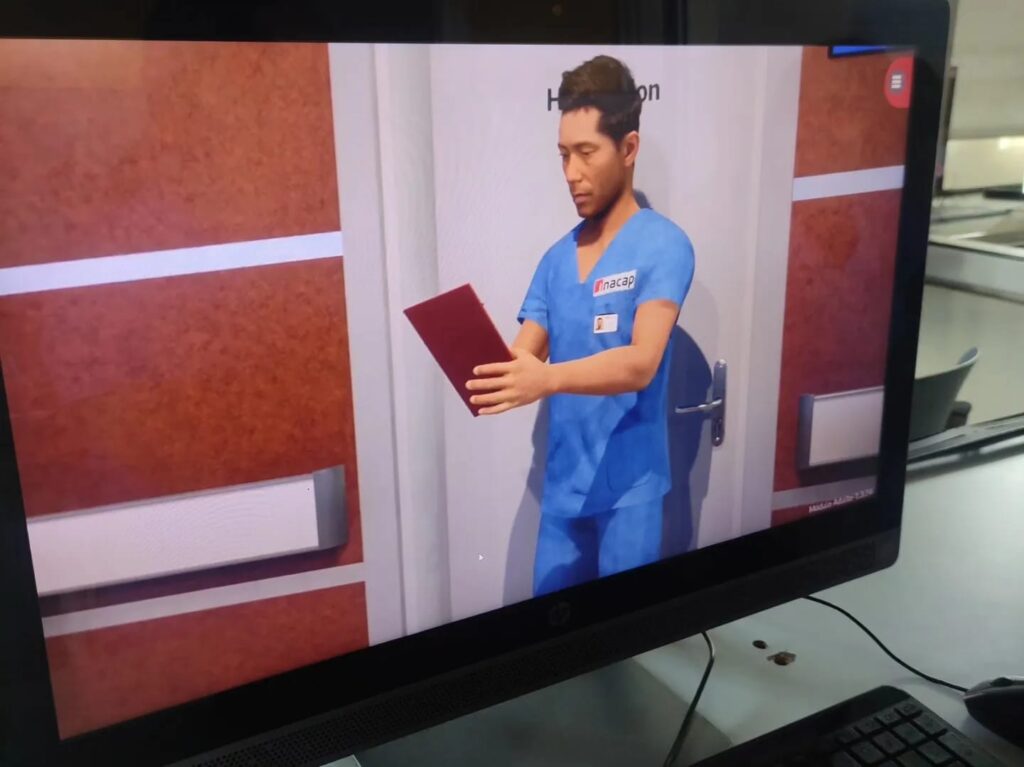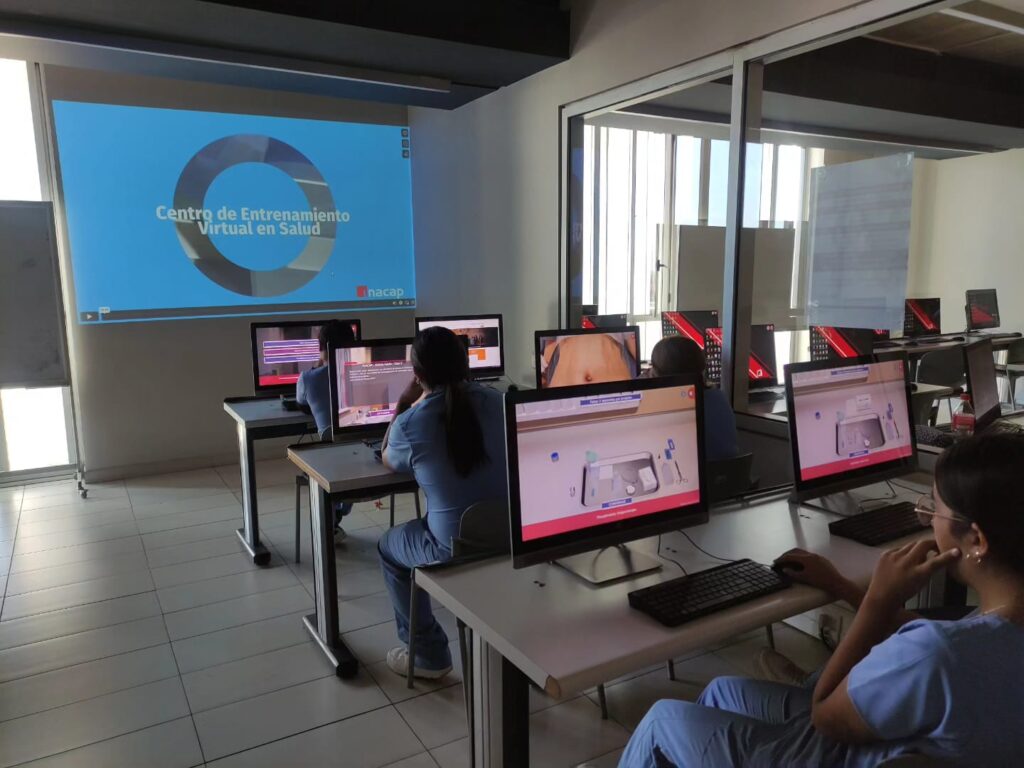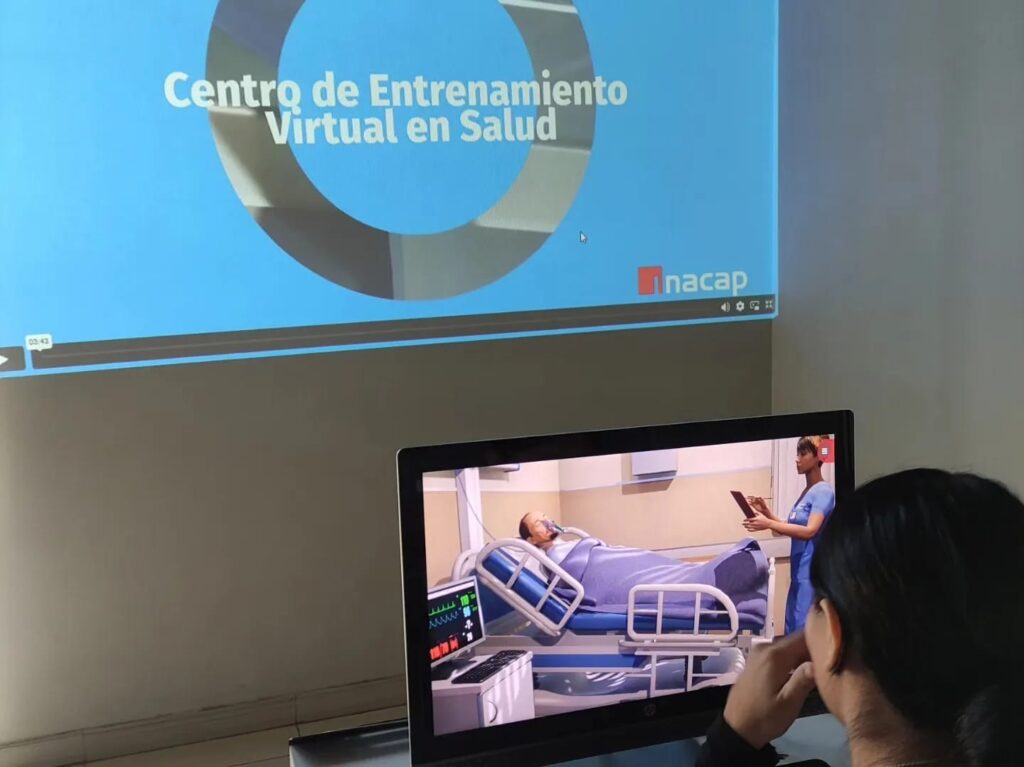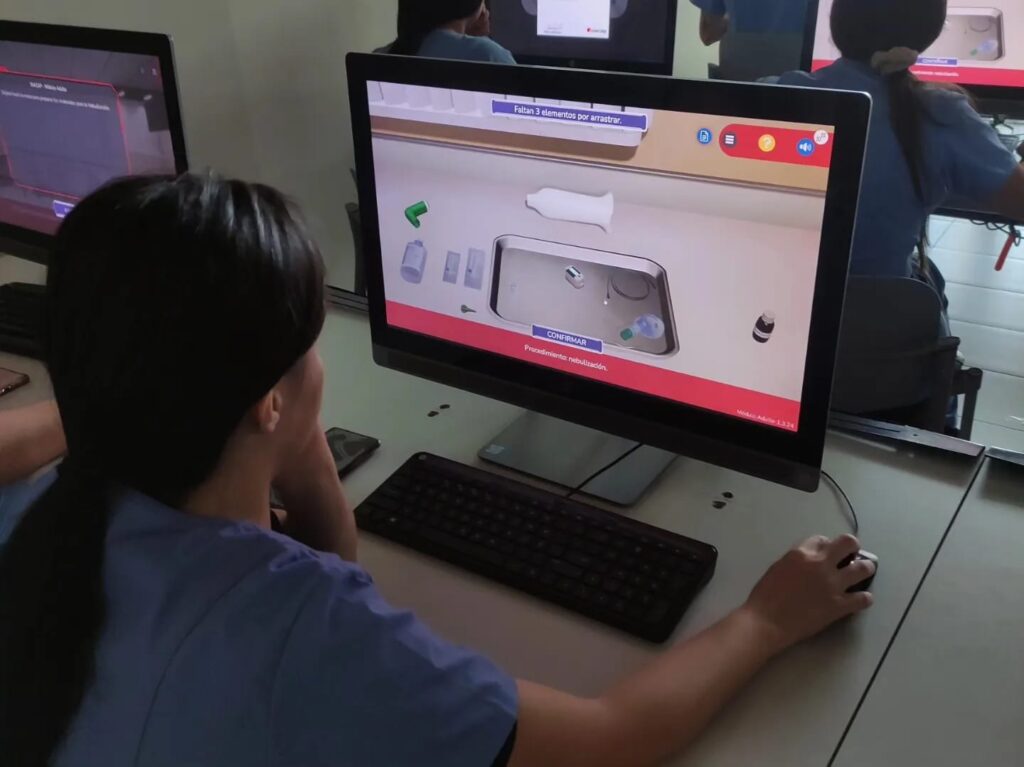As part of the student Nursing Technician training at INACAP in Chile (a higher education institution), we designed and created virtual learning scenarios that simulate hospital campuses. This experience allows students to put their knowledge into practice in real clinical situations in a safe virtual environment. The simulation of the patient’s care by the nurse in different clinical situations helps students learn to identify medical instruments and their correct handling. During their training, they can learn from their mistakes without fear because they receive advice and feedback from the teachers to reinforce their learning without causing harm to third parties.
Practicing in a virtual environment allows students to prepare themselves better before internships in health centers, hence the relevance of incorporating technologies and experiences that strengthen their training. In 2022, the pilot of clinical cases was launched at the INACAP Maipu campus. In the fall semester of 2023, virtual scenarios were formally incorporated into the subject of Medical-Surgical Nursing in the third semester of the degree program. In this article, I share with you how we integrated virtual simulation into the health program at INACAP. Likewise, it presents the results and evidence of implementing this educational methodology and the student‘s perception of the experience afterward.
According to Zuña Macancela (2019), virtual platforms offer personalized student-centered training, optimize teaching processes, and eliminate difficulties such as the time and space logistics of traditional face-to-face teaching. Recent studies on incorporating technological tools associated with patients or virtual scenarios report an improvement in students’ academic indicators because they obtained a better evaluation of their resolutions compared to those who never used the tool (Gutiérrez Acuña, 2020).
Virtual Learning Environments for Healthcare
The project implementation involved 135 Nursing Technician students attending INACAP’s computer laboratories at the Virtual Health Training Center (CEVSI) in Maipú in May 2023. The first class taught them how to use the platform, select an avatar, and begin one of the three available clinical cases. After the class, the group received instructions on entering the virtual simulation from their homes, as they could surpass the score obtained in class and learn from trial and error. The students commented that they could practice as often as they wanted to acquire knowledge, which benefited their learning and improved their scores.
The technology used in this project was an educational web platform. For this project, clinical cases were validated by technical specialists and were incorporated and transferred to virtual simulation. Students can access it from a computer, tablet, or cell phone. Note that this activity was not intended to be a summative assessment but a formative one, thus preparing the student to perform better once they completed their clinical internships.





The methodology was virtual asynchronous learning through videos or educational resources previously provided by the teacher, allowing each student to progress at their own pace (Castro Piedra, 2023). Students decide what, how, and when they want to learn in their learning process. However, variables such as their interest, practice, and technological resources influence the acquisition of competencies and skills.
Student Experience Outcomes and Perception
99.3% of the students passed the Medical-Surgical Nursing subject; only 0.7% failed the theoretical and practical components. The average score in the practical component was 6.3 on a scale of 7, which is used in the Chilean educational system. Therefore, it can be inferred that the CEVSI experience improved the students’ grades and their acquisition of clinical competencies (SIGA, INACAP, 2023).
At the end of the CEVSI virtual internship and before going to the clinical field, the students answered a satisfaction survey through the institutional email. The survey consisted of seven open-ended questions to determine their perception of the Virtual Health Training Center (CEVSI) at INACAP Maipú and its usability. 65.6% of the 135 participating students completed the survey. Below are some comments received.
Is the Virtual Health Training Center (CEVSI) useful and meaningful for your learning process?
95.4% answered affirmatively, indicating it was a space where they could learn; one commented, “Yes since we can remember and reinforce the procedures and carry them out more dynamically.” Another comment was, “It is beneficial because we can have more practice hours, which lets us manage our knowledge much better” (TENS student, 2023).
Regarding the type of scenarios and clinical cases, a survey question asked: Are the virtual scenarios realistic for your role and level of training?
96.5% answered affirmatively, versus 3.5% who answered that they could improve. Some affirmative comments were: “Yes, it feels like I am in a real hospital, and it helps me to verify my knowledge and put it into practice.” “Yes, even the noise of the virtual hospital and the patient interactions make the scenarios feel as real as possible.” Another student commented, “I like it because it simulates a hospital room very comparable to a hospitalization” (TENS student, 2023).
“The experience at the Virtual Health Training Center improved my technical skills. Why?” 93.1% of the answers were affirmative, complemented by the following statements: “The experience is great because it helps to reinforce the technical language, and also, these are the only instances where you can make a mistake and correct it immediately” (TENS student, 2023).
Before 2022, Nursing Technician students only had the option of carrying out procedural laboratories at the campus facility, so the survey asked: Does the Virtual Health Training Center replace or complement low-fidelity laboratories? Why?
92% of the responses indicated that the virtual health training center was complementary, with comments such as “They complement each other; in the laboratories, I carry out the procedure, and in the training center, I apply the knowledge acquired and also the practice” and “It does not replace them, it complements them; the virtual center could serve as previous training before a laboratory” (TENS student, 2023).
We also asked students if virtual simulation helps develop critical reasoning and decision-making. 89.7% of the answers were affirmative. Some comments were: “Yes, because when being with a patient, you cannot make mistakes, and the patient must be considered.” Also, “Yes, because the simulations put you in situations similar to daily life; they help you correct the decisions made and choose the right one” (TENS student, 2023).
Once the student completes each virtual clinical case, the system gives them a percentage of achievement to assess them formatively. For this reason, we asked if the percentage of achievement obtained in each clinical case encouraged them to repeat using the technological tool to improve their results.
96.5% of the answers were affirmative. Some comments were: “Yes, because maybe it did not go well for me, and I can do it again to realize where I went wrong.” “Of course, it does; I think if I try again, I will get a better percentage.” “Yes, it is a good tool to measure knowledge and encourage repetition and improvement” (TENS student, 2023).
Like any project that is started, it must have feedback from those who used it. Finally, we asked the students, “What improvements would you include?”
There are no right or wrong answers, but the ones that most attracted our attention in the analysis were: “The program itself is well executed; it could help if the most difficult branches had their virtual workshops since it is a more didactic aid for people who learn by doing.” “Maybe more scenarios and situations where students must interact with the material to be used.” “Start these simulations at the beginning of the subject, as a way of observing and then learning better what is being studied” (TENS student, 2023). The survey results revealed a negative perception of using a computer lab with old equipment that might have slowed down the process.
Reflection
The digital age in which we live invites us to update the curricula and educational practices to provide students with technological tools that improve the relationships between health professionals and patients.
Digitalized clinical cases logically guide students in procedures and decision-making, which help them acquire clinical competencies specific to their roles, facilitating patient safety.
As a teacher, I invite my colleagues who are dedicated to health education to incorporate technological tools, get advice, and work on clinical cases that can be digitalized. Create a committee of technical specialists and implement this methodology in your institutions to compare your student’s perceptions of the usability of a virtual health training center.
Finally, I leave you my contact information to share experiences and suggestions, help implement more virtual centers, or help you lose the fear that sometimes exists when incorporating virtual simulation. We must change the paradigm that health techniques should only be procedural in a physical, live laboratory. From the students’ perspective, a virtual center also helps them apply their knowledge complementarily in the teaching-learning process.
About the Author
Leonardo Elías Iturra Briceño (liturra@inacap.cl) is a nurse with a health superintendence registration number 213732, having experience in Emergency and ICU. He has a master’s degree in Pedagogy Applied to Higher Education, with 16 years of teaching experience and career management. He currently works as a Health Area Advisor at INACAP.
References
Alumno TENS. (May 2023). Encuesta sobre el Centro de Entrenamiento Virtual en Salud (CEVSI) INACAP Maipú. Santiago, Chile.
Basáez, E., & Mora, J. (2022). Salud e inteligencia artificial: ¿cómo hemos evolucionado? Santiago, Chile: Revista Médica Clínica Las Condes. Accessed at https://www.elsevier.es/es-revista-revista-medica-clinica-las-condes-202-pdf-S0716864022001262
Castro Piedra, L. (2023). Actividades Digitales Asincrónicas para Fortalecer el Aprendizaje de Estudiantes Adolescentes. Vol. 7. Ecuador: Ciencia Latina Revista Científica Multidisciplinar. Accessed at https://ciencialatina.org/index.php/cienciala/article/view/5917
Chambi-Mescco, E. (2023). Percepciones de los estudiantes de ciencias de la salud sobre el aprendizaje cooperativo en la modalidad virtual. 23. Lima, Perú: Horizonte Médico. Accessed at http://www.scielo.org.pe/pdf/hm/v23n2/1727-558X-hm-23-02-e2169.pdf
Córdova-Domínguez, J. (2007). Estudio piloto para la evaluación de la técnica de bloqueo simpático lumbar utilizando un modelo de simulación virtual. D.F., México: Revista Mexicana de Anestesiología. Accessed at https://www.medigraphic.com/pdfs/rma/cma-2007/cma072b.pdf
González Espangler, L. (2021). Los entornos virtuales de enseñanza aprendizaje y las habilidades en la especialidad de Ortodoncia. (Educación Médica Superior). Santiago de Cuba, Cuba. Accessed at https://ems.sld.cu/index.php/ems/article/view/2940/1239
Gutiérrez Acuña, Y. (2020). La simulación clínica en el entorno actual del aprendizaje virtual como una herramienta de innovación docente. Cusco, Perú: Yachay – Revista Científico Cultural. Accessed at https://revistas.uandina.edu.pe/index.php/Yachay/article/view/231/201
Iturra Briceño, L. E. (May 2023). Encuesta Centro de Entrenamiento Virtual en Salud (CEVSI) INACAP Maipú 2023. Santiago, Chile.
Pérez Acuña, C., Obach King, A., & Fuentes Olavarría, D. (2023). Recurso audiovisual para el desarrollo de competencias interculturales en salud en estudiantes de enfermería. Santiago, Chile: Educación Médica Superior. Accessed at https://ems.sld.cu/index.php/ems/article/view/3470/1491
SIGA, INACAP. (2023). Sistema Integrado de Gestión Académica, INACAP. Santiago, Chile.
Zuña Macancela, E. (May 22, 2019). Plataformas virtuales y fomento del aprendizaje colaborativo en estudiantes de Educación Superior. Vol. 1. (U. d. Oriente, Ed.) Ecuador: Sinergias educativas. Accessed at http://portal.amelica.org/ameli/jatsRepo/382/3821581025/index.html
Editing
Edited by Rubí Román (rubi.roman@tec.mx) – Editor of the Edu bits articles and producer of The Observatory webinars- “Learning that inspires” – Observatory of the Institute for the Future of Education at Tec de Monterrey.
Translation
Daniel Wetta
This article from Observatory of the Institute for the Future of Education may be shared under the terms of the license CC BY-NC-SA 4.0 
)
)
)